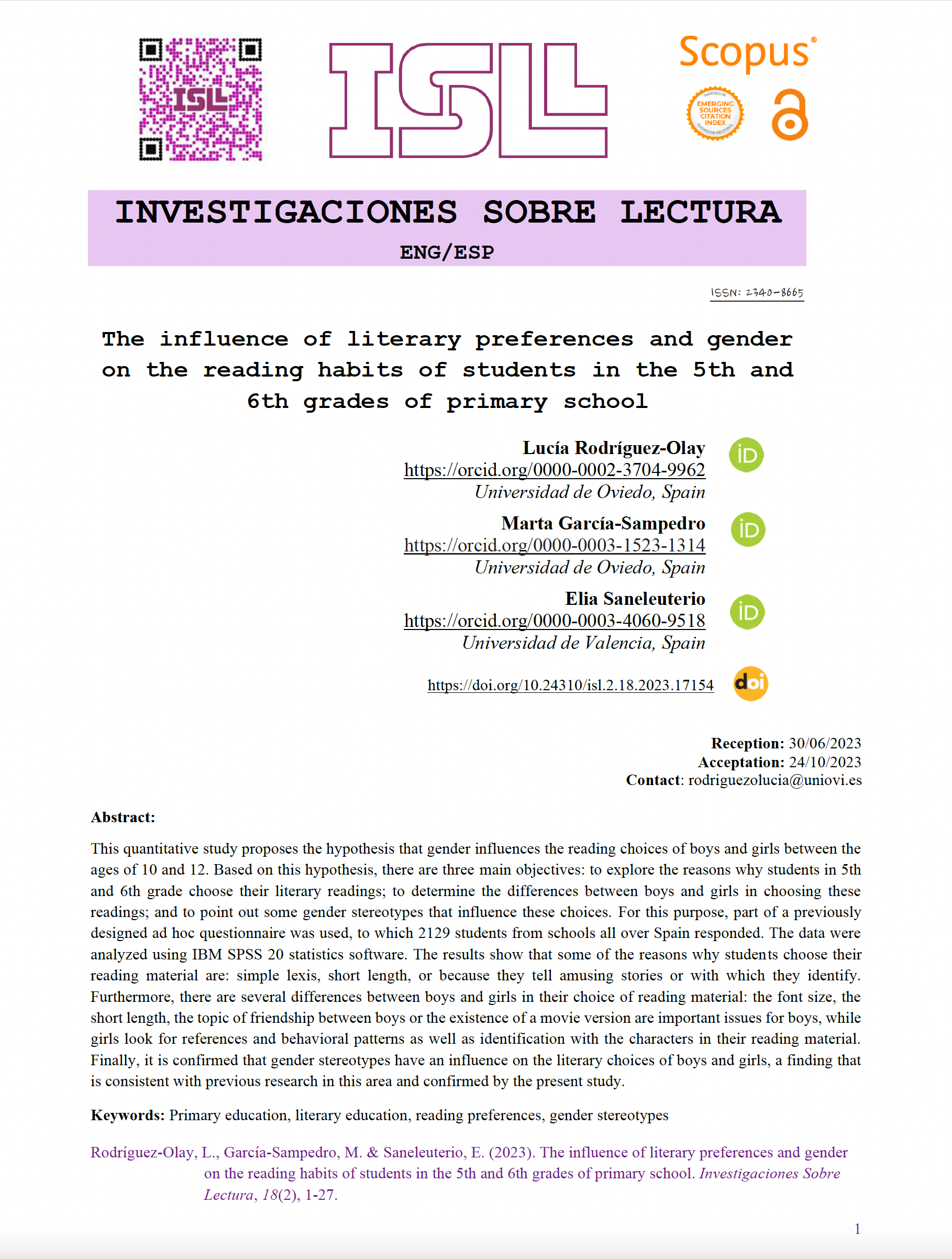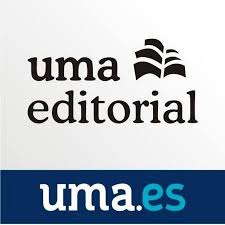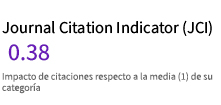LITERARY PREFERENCES AND GENDER INFLUENCES ON PUPILS´ READING HABITS IN THE 5TH AND 6TH YEARS OF PRIMARY EDUCATION
DOI:
https://doi.org/10.24310/isl.2.18.2023.17154Keywords:
primary education, literary training, reading preferences, gender, stereotypes.Abstract
This quantitative study presents three main objectives such as exploring the reasons why pupils in the 5th and 6th years of Primary Education choose their literary readings; determining if there are differences between boys and girls when selecting these readings; and knowing if gender stereotypes influence their reading choices at these ages. For this purpose, part of a previously designed ad hoc questionnaire was applied and responded by 2.129 pupils from schools all over Spain. The results indicate that some of the reasons why 10–12-year-old pupils choose their readings are a meaningful lexicon, short length texts, funny stories, or narratives to identify with. Additionally, multiple differences between boys’ and girls´ reading selection have been found. The size of the font, the brevity of the texts, the theme of friendship amidst boys, or the existence of a film version are important issues for lads, while girls search for referents and behavior patterns, as well as for identification with the reading characters. Finally, it is confirmed that gender stereotypes do influence boys and girls´ literary preferences, results that coincide with prior research developed in this field.
Downloads
Metrics
Publication Facts
Reviewer profiles N/A
Author statements
- Academic society
- N/A
- Publisher
- EduVerso, Universidad de Málaga
References
Arenas-García, L. (2013). Sexismo en adolescentes y su implicación en la violencia de género. Boletín Criminológico, 144, e4. https://bit.ly/2AU2QCY
Artola, T., Sastre, S., y Barraca, J. (2017). Diferencias de género en actitudes e intereses lectores: una investigación con alumnos españoles de primaria. Bordón. Revista de Pedagogía, 68(2), 11-26. https://doi.org/10.13042/Bordon.2016.37925
Banse, R., Gawronski, B., Rebetez, C., Gutt, H., y Morton, B. (2010). The development of spontaneous gender stereotyping in childhood: relations to stereotype knowledge and stereotype flexibility. Developmental Science 13(2), 298-306. https://doi.org/ 10.1111/j.1467-7687.2009. 00880.x
Bosch, E., Ferrer, V. A, García, E., Ramis, M. C., Mas, M. C., Navarro, C., y Torrens, G. (2007). Del mito del amor romántico a la violencia contra las mujeres en la pareja. Instituto de La Mujer, Ministerio de Igualdad.
Bosch, E., Herrezuelo, R., y Ferrer, V. A. (2019). El amor romántico, como renuncia y sacrificio: ¿Qué opinan los y las jóvenes? Femeris, 4(3), 184-202. https://doi.org/10.20318/femeris.2019.4935
Castillo, W. (2023). Do Elementary Students Reading Motivation Levels Differ by Racial/Ethnic And/Or Immigrant Background? Journal of Latinos and Education 22(2), 669-680. https://doi.org/10.1080/15348431.2020.1805615
Castillo-Mayén, R., y Montes-Berges, B. (2014). Análisis de los estereotipos de género actuales. Anales de Psicología, 30(3), pp. 1044-1060. https://doi.org/10.6018/analesps.30.3.138981
Clark, C. (2011). Setting the Baseline: The National Literacy Trust’s First Annual Survey into Young People’s Reading-2010. National Literacy Trust.
De Andrade, D., Homel, R., y Mazerolle, L. (2019). Boozy Nights and Violent Fights: Perceptions of Environmental Cues to Violence and Crime in Licensed Venues. Journal of Interpersonal Violence, 34(9), 1820-1842. https://doi.org/10.1177/0886260516657910
Delgado-Álvarez, M. C., Sánchez-Gómez, M. C., y Fernández-Dávila-Jara, P. A. (2012). Atributos y estereotipos de género asociados al ciclo de la violencia contra la mujer. Universitas Psychologica, 11(3), 769-777. https://core.ac.uk/download/pdf/27028424.pdf
Díaz-Aguado, M. J. (2003). Adolescencia, sexismo y violencia de género. Papeles del Psicólogo, 23(84), 35-44. https://bit.ly/3faEKCT
Escalante Varona, A., Soto Vázquez, J., y Gutiérrez Gallego, J. A. (2023). An approximation for reading habits among students of arts and education at the University of La Rioja (Spain). Investigaciones sobre Lectura, 18(1), 58-80. https://doi.org/10.24310/isl.v18i1.15757
Esteban, M. L., y Tavora, A. (2008). El amor romántico y la subordinación social de las mujeres: revisiones y propuestas. Anuario de Psicología, 39(1), 59-73.
Ferrer-Pérez, V., y Bosch-Fiol, E. (2013). Del amor romántico a la violencia de género. Para una coeducación emocional en la agenda educativa. Profesorado. Revista de Currículum y Formación del Profesorado, 17(1), 105-122. http://www.ugr.es/local/recfpro/rev171ART7.pdf
George, D., y Mallery, P. (2003). SPSS for Windows step by step: A simple guide and reference. 11.0 update (4th ed.). Allyn & Bacon. https://doi.org/10.4324/9781003205333
Gliem, J. A., y Gliem, R. R. (2003). Calculating, Interpreting, and Reporting Cronbach’s Alpha Reliability Coefficient for Likert-Type Scales. The Ohio State University.
Hernández, C. C. (2011). Reading is for Girls: Examining the Male View of Literacy. http://academic.laverne.edu/~ear/gsp/2011/CelinaCHernandez_ExaminingTheMaleViewOfLiteracy_Paper.pdf
Lanza, D., Moreno, G., De Diego, A., Ruz, C., y Moreno, A. (2012). Concepciones acerca de la amistad: un estudio exploratorio con niños españoles e inmigrantes afincados en la Comuni¬dad de Madrid. International Journal of Developmental and Edu¬cational Psychology 249. INFAD Revista de Psicología, 1(2), 293-302. https://doi.org/10.17060/ijodaep.2016.n1.v1.217
Logan, S., y Johnston, R. (2009). Gender differences in reading ability and attitudes: Examining where these differences lie. Journal of Research in Reading, 32(2), 199-214. https://doi.org/10.1111/j.1467-9817.2008.01389.x
López-González, R. C. (2019). Cortos de animación en la red para todos los públicos y género: temáticas y roles de siempre contados como nunca. Comunicación y Género, 2(2), 249-265. https://doi.org/10.5209/cgen.66515
Luengo, T., y Rodríguez, C. (2009). El mito de la “fusión romántica”. Sus efectos en el vínculo de la pareja. Anuario de Sexología (11), 19-26.
Marinak, B. A., y Gambrell, L. B. (2010). Reading motivation: Exploring the elementary gender gap. Literacy Research and Instruction, 49(2), 129-141. https://doi.org/10.1080/19388070902803795
McGeown, S. P. (2015). Sex or gender identity? Understanding children’s reading choices and motivation. Journal of Research in Reading, 38(1), 35-46. https://doi.org/10.1111/j.1467-9817.2012. 01546.x
Merisuo-Storm, T. (2006). Girls and boys like to read and write different texts. Scandinavian Journal of Educational Research, 50(2), 111-125. https://doi.org/10.1080/00313830600576039
Míguez-Álvarez, C., Agrelo-Costas, E., y Mociño-González, I. (2023). “¿Qué recomiendo leer y por qué?” Preferencias lectoras del profesorado de Educación Infantil y Primaria en formación. Investigaciones sobre Lectura, 18(1), 27-57. https://doi.org/10.24310/isl.v18i1.15736
Monforte, J., y Úbeda-Colomer, J. (2019). ‘Como una chica’: un estudio provocativo sobre estereotipos de género en educación física. Retos, 36, 74-79. https://doi.org/10.47197/retos.v36i36.68598
Moya-Mata, I., Ruiz-Sanchis, L., Martín-Sanchis, J., y Ros-Ros, C. (2019). Estereotipos de género en las imágenes que representan las actividades en el medio natural en los libros de Educación Física de Primaria. Cultura, Ciencia y Deporte, 14(40), 15-23. https://doi.org/10.12800/ccd.v14i40.1222
Muñiz, J., y Fonseca-Pedrero, E. (2019). Diez pasos para la construcción de un test. Psicothema, 31(1), 7-16.
Muñoz, C, Schonemann F., Sánchez, P., Santander, S., Pérez, M., y Valenzuela, J. (2012). Características psicométricas de una escala para caracterizar la motivación por la lectura académica. Revista Electrónica de Investigación Educativa, 14(2), 118-132. https://doi.org/10.7203/relieve.20.1.3878
Oviedo, H. C., y Campo-Arias, A. (2005). Aproximación al uso del coeficiente alfa de Cronbach. Revista Colombiana de Psiquiatría, 34(4), 572-580. https://doi.org/10.7705/biomedica.v26i4.327
Ramos Cambero, M. M., y Saneleuterio, E. (2021). Análisis de cuatro novelas juveniles para la coeducación. Profesorado. Revista de Currículum y Formación del Profesorado, 25(1), 1-21. https://doi.org/10.30827/profesorado.v25i1.14068
Rebollo, A. (2010). Perspectiva de género e interculturalidad en la Educación para el Desarrollo. En Género en la Educación para el Desarrollo. Abriendo la mirada a la interculturalidad (pp. 11-32). Universidad del País Vasco / Hegoa / ACSUR. https://bit.ly/3C7M3qo
Rodríguez-Olay, L. (2022). Estereotipos de género y literatura: diseño de un cuestionario para alumnado y profesorado de Primaria. Investigaciones Feministas, 13(1), 359-374. https://doi.org/10.5209/infe.76369
Ruiz-Repullo, C. (2016). Voces tras los datos. Una mirada cualitativa a la violencia de género en adolescentes. Instituto Andaluz de la Mujer.
Saneleuterio, E., y Soler-Campo, S. (2021). Validación y aplicación de un instrumento para el análisis de estereotipos de género en largometrajes de dibujos animados. Profesional de la Información, 30(5), e300503. https://doi.org/10.3145/epi.2021.sep.03
Schwabe, F., McElvany, N., y Trendtel, M. (2015). The school age gender gap in reading achieve¬ment: Examining the influences of item format and intrinsic reading motivation. Reading Re¬search Quarterly, 50(2), 219-232. https://doi.org/10.1002/rrq.92
Serra, C. (2019). Manual Ultravioleta. Penguin Random House.
Shrestha, N. (2021). Factor Analysis as a Tool for Survey Analysis. American Journal of Applied Mathematics and Statistics, 9(1), 4-11. https://doi.org/10.12691/ajams-9-1-2
Sureda, I., García-Bacete, F. J., y Monjas, M. I. (2009). Razones de niños y niñas de diez y once años para preferir o rechazar a sus iguales. Revista Latinoamericana de Psicología, 41(2), 305- 321.
Tabernero Sala, R., Campos Bandrés, I. O., y Briz-Villanueva, E. (2022). An Exploration of the Intervention of Individual and Contextual Variables in the Reading Motivation of Preadolescent Students. Investigaciones sobre Lectura, 17(2), 110-132. https://doi.org/10.24310/isl.vi18.14656

Downloads
Published
Versions
- 2024-01-02 (3)
- 2023-12-22 (2)
- 2023-12-22 (1)
How to Cite
Issue
Section
License
Copyright (c) 2023 Lucía Rodríguez-Olay, Marta García-Sampedro, Elia Saneleuterio

This work is licensed under a Creative Commons Attribution-NonCommercial-ShareAlike 4.0 International License.
All contents published in Investigaciones sobre la Lectura are protected under the Creative Commons Attribution-NonCommercial-ShareAlike 4.0 International (CC BY-NC-SA 4.0) license. All about this license is available in the following link: <http://creativecommons.org/licenses/by-nc-sa/4.0>
Users can copy, use, redistribute, share and exhibit publicly as long as:
- The original source and authorship of the material are cited (Journal, Publisher and URL of the work).
- It is not used for comercial purposes.
- The existence of the license and its especifications are mentioned.
There are two sets of authors’ rights: moral and property rights. Moral rights are perpetual prerogatives, unrenounceable, not-transferable, unalienable, imprescriptible and inembargable. According to authors’ rights legislation, Investigaciones sobre la Lectura recognizes and respects authors moral rights, as well as the ownership of property rights, which will be transferred to University of Malaga in open access. The property rights are referred to the benefits that are gained by the use or the dissemination of works. Investigaciones sobre la Lectura is published in an open access form and it is exclusively licenced by any means for doing or authorising distribution, dissemination, reproduction, , adaptation, translation or arrangement of works.
Authors are responsable for obtaining the necessary permission to use copyrighted images.











31.png)









